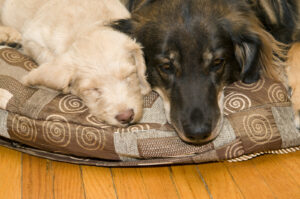Barks Blog
Dog Training: Why I Do It
By Joanne Ometz

Eight people enter the room with five puppies. I encourage whole families to attend my puppy classes. “Let’s get everyone on the same page,” I have told them, so parents, kids, couples, and single puppy parents arrive, leading or being led by their puppies. All take their places, sitting and immediately beginning to lower treats to the floor by their young dogs, who begin to slow down, sit, or lie down, to settle. Soon, we have a room full of quiet people with puppies lying at their feet, waiting for the others to arrive, waiting for class to begin.
This is my favorite time of every class. Regulation of the nervous system is happening. Children sitting quietly, spouses collaborating, all teaching their puppies what calm behavior is. At peace for a few moments, being together.
Next comes a period of training. Today’s lesson is ‘sit’ and ‘down.’ Then, controlled chaos ensues as people take turns going from station to station for puppy physical education, including a puppy sized dog walk and tunnels. Puppies on leashes are everywhere, trying different textures and wobbly things and being just slightly off the floor, getting up and getting down. Puppies learning they can be safe with unfamiliar objects and surfaces. Humans learning how brave and curious their puppies can be, given the opportunity to go at their own pace.
On another day I go to a couple’s home for the third time. They have two leash reactive dogs, each one ‘belongs’ to one spouse. The wife is afraid of the husband’s dog, a large active terrier. The tension in the room is palpable. Every time the terrier moves towards her dog, the woman tells him, “Go to your mat!” The husband sits without speaking. The terrier complies for a moment then gets back up, trying to engage the other less confident dog, in what quickly progresses from an invitation to play to bullying. I observe the dogs and the owners, and the process repeats itself. The terrier has learned that the only way to get attention is to act out.
I ask both owners to work with the other’s dog on their respective mats, rewarding for calm behavior , dropping treats one at a time, looking for anything remotely like calm and reinforcing it. The dogs start to relax and I ask the humans to take a breath, explaining that their mood is reflected in their body language, so calming themselves will help calm their dogs.
For the first time, the tension eases. The terrier is down on his mat, lying slightly on one hip. I say, “Try practicing this every day; see what happens. And do it with each other’s dogs.” This makes the wife nervous and she asks if she can do it with her own dog. I encourage her to do it both ways.
Now I see how these dogs have become a metaphor for the relationship. The dogs, with wildly different temperaments, are part of a divide that is hard to cross. I am here as a dog trainer, not a relationship counselor.
It is possible the leash reactivity will improve and the indoor behavior will not. It is possible the humans have too much at stake to let it get better. And this is where I have to notice this, accept it, and focus on what I can actually help them with. “At least,” I think, “the leash reactivity is better.”
Today, the owners let me know they have started to trust me. Not directly, but by telling me they want to work on desensitizing the terrier to his muzzle for vet visits. He must be sedated and muzzled because he gets so frightened. They want to desensitize the wife’s dog to having his feet touched. This is a couple who decided to pay more per session rather than buy a package, and now I understand their discomfort. They are finally, however, beginning to realize that change might bring some relief.
I smile inwardly. Rewarding the dogs for calm behavior has already brought more peace to this household. My job as a dog trainer is to reduce suffering. It can include the humans’ along with their dogs’, and that’s fine with me.
About the Author
Joanne Ometz is a professional dog trainer who operates The Dog Lady in Durham, North Carolina. She is one of a handful of people in the U.S. to have completed Turid Rugaas’ year-long certification course. She combines Rugaas’ techniques with clicker training and Dr. Stephen Porges’ Polyvagal Theory to work with clients and their dogs in a holistic manner.

